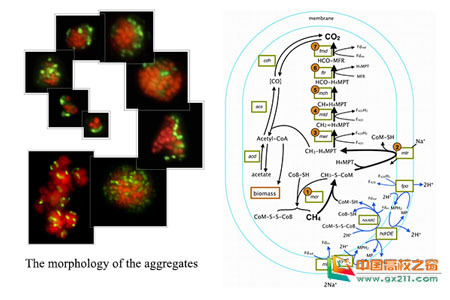Recently, the Shanghai Jiaotong University Microbiology and Oceanography Laboratory published a research article "Methanotrophic archaea possessing diverging methane oxidizing and electrontransporting pathways" in the International Society of Microbiology and Ecology "The ISME Journal", which explained the various electron transport of anaerobic methane oxidizing bacteria This approach confirmed that anaerobic methane oxidation has a biological basis that follows the reverse reaction of the methanogenesis process.

The anaerobic oxidation of methane (AOM) consumes 85% of the global annual methane production in the oceans. It is a key step in controlling the release of methane in the oceans and directly affects global climate change. At the same time, the standard Gibbs free energy theoretical calculation value in the AOM process is only -16.6kJ / mol CH4, which is close to the limit of bioavailable energy. It is a typical low-energy biological process in the extreme environment of the deep sea. The microorganism that plays a key role in this process is a group of archaea temporarily named as anaerobic methane oxidizing bacteria (ANME, anaerobic methanotrophic archaea). ANME grows slowly, and the growth time is several months. At present, no laboratory in the world can obtain pure culture of ANME. The Microbial Oceanography Laboratory conducted deep-sea cold spring simulation and low-temperature and high-pressure microbial culture system (the only known long-term gas-liquid mixed high-pressure flow culture system) independently designed and developed on the marine mud volcano environment sample for up to After three years of enrichment cultivation, ANME-2 enrichment was obtained. Further metagenome, macrotranscriptome, single cell cluster sorting and genome sequencing analysis revealed that all the key 7-step enzyme genes in the methane production pathway are present and expressed in ANME-2. At the same time, the analysis of the energy metabolism pathway of ANME-2 found that there is no classic hydrogenase in ANME-2 cells, but there are gene expressions of key enzymes such as Fpo, Hdr, Cytochrome C, Rnf and other electron transport pathways, indicating its energy metabolism Diversity. The study confirmed that anaerobic methane oxidation is the reverse reaction of methane production from multiple angles of chemical reaction, genomics and transcriptomics, and proved that ANME-2 has evolved a variety of energy metabolism mechanisms to adapt to low-energy environments and respond quickly environmental change.
This work will greatly promote the study of AOM, a key biological process in the marine carbon cycle, and contribute to an in-depth understanding of biological processes in low-energy environments and the adaptive mechanisms of organisms to low-energy environments; at the same time, it also contributes to the origin and early life The study of the evolution of the earth's environment provides a basis for modern biology. In this research project, Shanghai Jiaotong University Microbiology and Oceanography Laboratory made comprehensive use of bioengineering and molecular biology techniques, and cooperated with Ghent University in Belgium, Bremen University in Germany and Fudan University to coordinate research. The research was supported by the National Key Basic Research Development Program (2011CB808800), the National Natural Science Foundation of China (91228201, 31290232), and the "863" project (2012AA092103-2).
Gym Bike,Exercise Bicycle,Stationary Exercise Bike,Magnetic Exercise Bike
Zhejiang Kingdom Sports Co.,Ltd. , https://www.zjkingdomsports.com